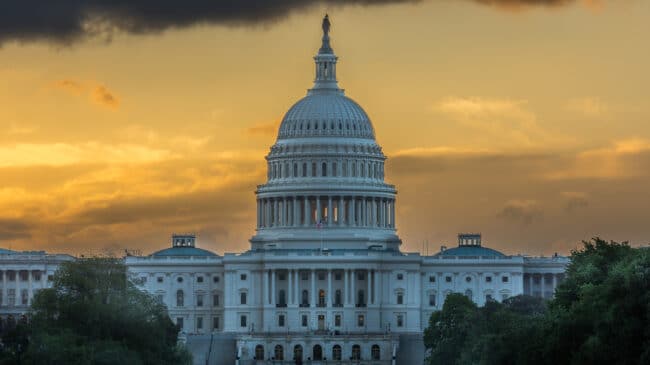Spiraling federal budget deficits since the beginning of this century — and projected to continue for as far as the eye can see — are undermining America’s economic future. Contrary to popular wisdom on the right, the practice of persistently spending more money than the federal government collects is a bipartisan convention.
As the country enters uncharted territory for its debt-to-gross domestic product (GDP) ratio, there are serious risks, especially from inflation, which the Federal Reserve may think is needed to finance the nation’s nearly $29 trillion mountain of debt.
According to Congressional Budget Office (CBO) data, the ratio of publicly held federal debt increased from 32% of GDP in 2001 to 102% today, and is expected to hit 202% in the next 30 years.
While it may be convenient to blame Democrats for this rapid accumulation of debt, Republicans bear a large share of responsibility. After President Bill Clinton and Congressional Republicans partnered to balance the budget in the late 1990s, federal budget deficits returned under President George W. Bush.
Bush cut taxes in 2001 and 2003 without making spending cuts. He also started the long and costly wars in Afghanistan and Iraq. According to the Costs of War Project at Brown University, the budgetary costs of these conflicts exceeds $2 trillion. And that’s only the tip of the iceberg: the wars continue to drive increased spending on veterans’ benefits and decades of deficit spending triggered additional borrowing costs. When other Pentagon spending on the ‘War on Terror’ is included, Brown researchers estimate costs of about $8 trillion since 2001.
President Bush and Republicans also added prescription drug benefits to Medicare, without paying for them, and, ironically, with very little support from House Democrats. CBO projects that this benefit will add about $1.4 trillion to federal deficits over the next 10 years—more than this year’s $1.2 infrastructure bill, another bipartisan deficit builder, if it is passed.
While former President Barack Obama is often blamed for the first trillion-dollar deficit in fiscal year 2009, almost a third of that fiscal year (October 1, 2008 to January 20, 2009) transpired under the Bush administration. Although Obama’s main policy response to the Great Recession, the American Recovery and Reinvestment Act cost $831 billion, less than half of that was incurred in FY 2009.
Of course, the single largest budget deficit in American history occurred under President Donald Trump and a Republican-controlled Senate. The fiscal year 2020 deficit of $3.1 trillion even exceeds the most recent year’s $2.8 trillion shortfall, which is a shared responsibility of the Trump and Biden administrations as well as bipartisan Congressional majorities for all but the final COVID-19 stimulus bill.
Although the most recent gargantuan deficits can be blamed on COVID-19, it is worth noting that federal deficits were rising under President Trump even in the strong economy before the pandemic. In Obama’s last full fiscal year, 2016, the federal government recorded $585 billion in red ink compared to Trump’s $984 billion deficit in 2019 — before the pandemic.
But, regardless of blame, political gridlock via a Republican takeover of the House in 2022 may offer the best short-term prospect for tackling the debt crisis. A Democratic president coupled with a Republican Congress has been the best combination for limiting federal spending in recent decades.
Unfortunately, much of the political left, influenced by the precepts of Modern Monetary Theory, have become “deficit denialists.” They point to decades of warnings that debt and deficits would create an economic crisis that, thankfully, hasn’t arrived yet and assume that means deficit spending and borrowing, like the proposed $3.5 trillion reconciliation bill, can continue indefinitely without consequence.
But if major fiscal reform at the federal level does not start soon (and probably even if it does), the U.S. will face serious economic consequences from the last 20 years of fiscal irresponsibility. This year we’re seeing significant inflation, but the Federal Reserve will continue to accommodate large deficits by printing money to purchase bonds and will keep interest rates artificially low. If the Fed allows interest rates to rise to an economically rational level, it risks triggering a bear market in stocks and further spiking federal borrowing costs via higher interest payments.
So the politically easier solution for the Fed is to devalue the debt by depreciating the dollar. Unfortunately, this could help cause a return to the double-digit inflation and frequent economic recessions the country suffered in the 1970s.
It’s difficult to imagine either major political party seriously addressing the national debt right now. Eventually, to make a lasting improvement in our debt trajectory, Congress should implement process reforms such as zero-based budgeting, pay-as-you-go procedures that have real teeth, and debt-to-GDP targeting (which may receive more bipartisan support than balanced budget amendments that have failed to pass in previous Congresses). In the meantime, Congress can at least stop the massive annual deficit spending that keeps adding to the debt.
A version of this column previously appeared in the Daily Caller.

